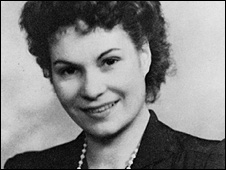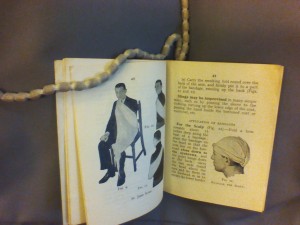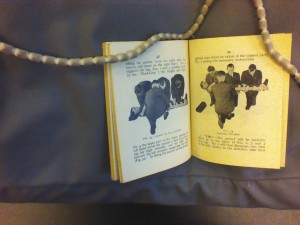Miss J. Hunter Dunn, Miss J. Hunter Dunn, Furnish’d and burnish’d by Aldershot sun
– John Betjeman, A Subaltern’s Love Song
In preparation for this year’s Bloomsbury Festival we are exploring various documents in the Senate House Library archives that look at Senate House during its occupation as the Ministry of Information. In our previous post we looked at how University workers were used by the Ministry during the Second World War. This post continues that theme in an abstract way by examining an artefact once belonging to Joan Hunter Dunn, the catering manageress for Senate House.
Joan Hunter Dunn and her First Aid book

Joan Hunter Dunn
After the war, Joan Hunter Dunn became something of a minor celebrity figure becoming the muse for Sir John Betjeman. She is best known as being the subject of Betjeman’s poem “A Subaltern’s Love-song” (to read this poem have a look at it on the Poetry Archive website).
Amongst items that once belonged to Dunn the Senate House Library has a copy of a small pocket-sized first aid book stamped with the Ministry of Information on the front cover. The advice given within it hasn’t changed too much over the decades, but there are variations of emphasis and some changes to practice. Most noticeable in this edition (the 39th edition of the authorized textbook of the St John Ambulance Association) is the consistent emphasis on the male gender. Women are barely mentioned. Both patient and carer are assumed to be male. The language, also, is antiquated, attempting to appeal to the office worker of modern day 1930s/40s.
What is First Aid?
 The book begins with a chapter on ‘First Aid – what is it’:
The book begins with a chapter on ‘First Aid – what is it’:
First Aid to the Injured is the application of simple rules, based on the principles of practical medicine and surgery, before the arrival of a doctor. The objects of First Aid are:-
1. To PRESERVE the life of the patient
2. To PROMOTE recovery
3. To PREVENT the aggravation of the injury or condition
The First-Aider must always remember that he is not a doctor, and that his duty is strictly limited to giving prompt help to meet the immediate needs of the patient. A DOCTOR’S HELP should be obtained AT THE EARLIEST POSSIBLE MOMENT, and, when sending for him, he should be informed of the most important particulars of the case, if possible in writing.
It must always be remembered that whatever the injury, SHOCK will be present in a greater or less degree, and, in cases where shock is severe, the patient may die as a result of it. The best remedies for shock are WARMTH, FRESH AIR, and REST, so that in every case of injury the treatment must be given in addition to the treatment required for the particular type of injury or illness.
The introduction goes on to stress that in many cases it is not wise to raise the head in cases of accident, even though it is the natural impulse to do so. It also states the obvious that “if the patient is not breathing, breathing must be restored or he will surely die” and similarly states that “if blood is spurting from a wound and bleeding is not stopped, the patient will bleed to death”. Stimulants such as spirits should not be given, but hot drinks such as milk or strong tea/coffee are considered safer; water even better.
What to do in emergencies
The book covers the usual fractures, faints, head injuries, bleeding nose and so forth. Later in the book we are told that patients should be prevented from rubbing their eye if they get grit in it (children should be tied down if necessary). In cases of unconsciousness or insensibility patients should be persuaded not to resume work until seen by a doctor. To give an indication of the type of thing to expect under ‘Additional treatment in special cases’ we are told the following:
STRANGLING
Cut and remove the band around the throat
HANGING
Do not wait for a policeman but grasp the lower limbs and raise the body to slacken the rope; cut the rope and free the neck
CHOKING
To dislodge the obstruction in the throat, bend the head and shoulders forward and thump the back hard between the shoulder blades. If this is unsuccessful, open the mouth – forcibly if need be; pass two fingers right to the back of the throat to encourage vomiting.
SWELLING ABOUT THE THROAT
If possible lay the patient before a fire. Apply a hot compress to the front of the neck from the chin to the top of the breast-bone. Renew the hot compress frequently. If breathing has not ceased or has been restored, give ice to suck or failing ice, cold water to drink. Butter, olive oil, or medicinal paraffin may also be given.
SUFFOCATION BY SMOKE
Before entering a building or room full of smoke tie a handkerchief, wet if possible, over the nose and mouth. Keep low, and quickly but cautiously drag the patient out.
SUFFOCATION BY POISONOUS GAS
On entering any enclosed space known or suspected to contain poisonous gas of any kind, ensure a free circulation of air by opening or breaking doors and windows. Hold your breath, keep low, and remove the patient as quickly as possible. In cases where ventilation is not possible and the character of the gas is known to be deadly, a suitable gas mask should be worn.

CONVULSIONS
When convulsions are present, support the patient’s head, and after wrapping a piece of wood or any other hard material in a handkerchief, hold it in his mouth to prevent biting the tongue. Do not forcibly restrain his movements, but prevent him from hurting himself by pulling him away from a source of danger, such as machinery, a wall, or fireplace. Light pieces of furniture should be pushed out of the way.
GERMS
The air and all our surroundings teem with minute germs, which multiply with extreme rapidity. Some of them, when they gain admission to the body, are capable of causing very serious diseases. The skin, as long as it is uninjured, guards against their entry, but the moment it is wounded they can get in. If the wound is kept perfectly clean it will heal much better and with far less risk of disease.
In all J. Hunter Dunn’s first aid book is a product of its times. Published in 1940 it was designed for men, but was obviously just as likely to be used by women. At this year’s Bloomsbury Festival the School of Advanced Study are putting on an exhibition sourced in part from the Senate House Library collections from its time as the Ministry of Information. To find out more check out the Bloomsbury Festival 2013 programme or our Festival Highlights post.
The Bloomsbury Festival runs from October 15-20, 2013. The full schedule of events at the School of Advanced Studyis available here. We are also running a series of exciting competitions in October. Follow us on @SASNews for festival news and updates.
Finding the Ministry of Communication:
Senate House, Malet Street, London


